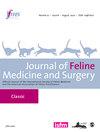25 只猫的α-氯糖中毒:临床表现和静脉注射脂质乳剂治疗评估
IF 1.9
2区 农林科学
Q2 VETERINARY SCIENCES
引用次数: 0
摘要
本研究旨在描述α-氯醛糖(AC)中毒猫的临床表现和病情发展,并确定静脉注射(IV)脂质乳剂(ILE)是否会影响 AC 的血清浓度或临床症状。这些猫被随机分为两组:一组接受 20% ILE,剂量为 300 毫克/千克(2 分钟),然后在 30 分钟内以 1500 毫克/千克的速度持续输注(IL+ 组);另一组接受醋酸林格氏液静脉输液治疗(IL- 组)。在入院后的 0、2、12 和 24 小时抽取血清样本。采用一种新型的、经过验证的、定量的超高效液相色谱-串联质谱法对样本进行 AC 检测。采样时会记录生命体征和预定义的临床体征,并使用之前描述的中毒严重程度评分对患者进行评分。出院后进行电话访谈以评估疗效:IL+ 组 13 只,IL- 组 12 只。发病时最常见的临床症状是震颤(22 只,88.0%)、颅神经缺损(20 只,80.0%)和心动过缓(19 只,76.0%)。在任何时间点,IL+ 组和 IL- 组的 AC 浓度或中毒评分随时间的变化均无明显差异(P >0.05)。所有猫都在 72 小时内恢复了健康。结论和相关性 ILE 对 AC 中毒猫的 AC 血清浓度或临床症状没有任何影响。所有猫都存活到了后续治疗。对于急性出现所述神经症状的猫,AC 中毒是一个重要的鉴别诊断,预后极佳。本文章由计算机程序翻译,如有差异,请以英文原文为准。
Alpha-chloralose poisoning in 25 cats: clinical picture and evaluation of treatment with intravenous lipid emulsion
ObjectivesThe aims of this study were to describe the clinical picture and progression in cats with alpha-chloralose (AC) intoxication and to determine if treatment with intravenous (IV) lipid emulsion (ILE) influenced either the serum concentration of AC or the clinical signs.MethodsCats with suspected AC poisoning admitted to a university small animal hospital were included. The cats were randomised into two groups: one receiving 20% ILE at a dose of 300 mg/kg as a 2 min bolus, followed by a 1500 mg/kg continuous rate infusion over 30 mins (IL+ group) and the other receiving IV fluid therapy with Ringer’s acetate (IL− group). Serum samples were drawn at 0, 2, 12 and 24 h after admission. Samples were tested for AC with a novel validated, quantitative, ultra-high-performance liquid chromatography-tandem mass spectrometry method. Vital and predefined clinical signs were noted at the times of sampling and patients were scored using a previously described intoxication severity score. Telephone interviews were conducted after discharge to assess outcome.ResultsA total of 25 cats were enrolled: 13 cats in the IL+ group and 12 in the IL− group. The most common clinical signs at presentation were tremor (n = 22, 88.0%), cranial nerve deficits (n = 20, 80.0%) and bradycardia (n = 19, 76.0%). No significant difference in AC concentration or change in intoxication score over time was found between the IL+ and IL− groups at any time point ( P >0.05). All cats recovered within 72 h.Conclusions and relevanceILE did not have any effect on the AC serum concentration or clinical signs in AC-poisoned cats. All cats survived until follow-up. In cats with an acute onset of the described neurological signs, AC intoxication is an important differential diagnosis with an excellent prognosis.
求助全文
通过发布文献求助,成功后即可免费获取论文全文。
去求助
来源期刊
CiteScore
3.90
自引率
17.60%
发文量
254
审稿时长
8-16 weeks
期刊介绍:
JFMS is an international, peer-reviewed journal aimed at both practitioners and researchers with an interest in the clinical veterinary healthcare of domestic cats. The journal is published monthly in two formats: ‘Classic’ editions containing high-quality original papers on all aspects of feline medicine and surgery, including basic research relevant to clinical practice; and dedicated ‘Clinical Practice’ editions primarily containing opinionated review articles providing state-of-the-art information for feline clinicians, along with other relevant articles such as consensus guidelines.

 求助内容:
求助内容: 应助结果提醒方式:
应助结果提醒方式:


